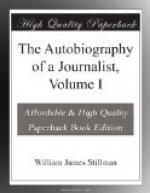In fact, if we consider the differences between the system of education in painting and that in music or any other art or occupation in which the highest executive ability is required, we shall see that we give insufficient opportunity for the painter’s hand to acquire the subtle skill we find in the successful violinist or pianist, and which is due to the early and incessant practice in the manual operations of his art. The fact is recognized, that the education of a violinist must begin in the early years, when the will and hand are flexible, and not merely the training, but the occupation, is almost exclusive, for the specialist is made only by a special and relatively exclusive devotion to the particular faculties which are desired to be trained. It is useless to attempt to develop the finest qualities of the draughtsman without the same attention to the condition of training which we insist on in the musician. The theory may come later, the intellectual element may develop under many influences, and healthily, later in life, but the hand is too fine and subtly constituted an implement to be brought into its best condition and efficiency unless trained from the beginning to the definite use imposed on it.
Admitting, therefore, as I do, that the criticism of Delacroix was just, it is evident that, until we give to the modern student of painting a similar training to that which the early one had, we cannot expect him to attain the executive powers of the Italian renaissance, nor can we be sure that he appreciates the subtlety of the work of the masters, any more than the member of a village choir can understand the finesse of the highest order of musical execution, or its first violinist appreciate the touch of a Joachim or a Sarasate. For it is just in the last refinement of touch of a Raphael drawing or the rapid and expressive outline of a Mantegna that we find the analogy between the two arts, in a refinement of touch which is lost on the public, and appreciated only by the practiced student either of music or painting. This final attainment of the hand is only possible to a man who has been trained as a boy to his work. We find it in a water-color drawing of Turner, as in a pencil drawing of Raphael, and in the outlines of the ceiling of the Sistine Chapel, but in modern figure painting never, even in France, where the youth generally takes up the training at fourteen to sixteen. I believe that the reason why this supreme manual excellence is so completely lacking, even in French art, that, so far as I know, only Meissonier amongst them has attained a measure of it, is that the seriousness of life and purpose necessary for any consummate achievement is so rarely found there in conjunction with that early and sound training.




